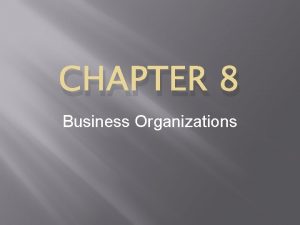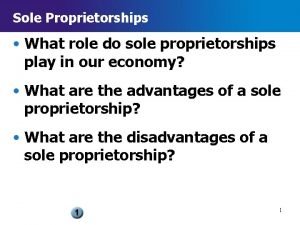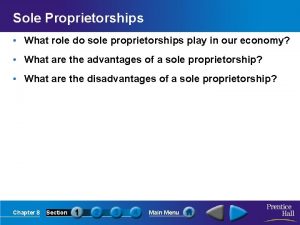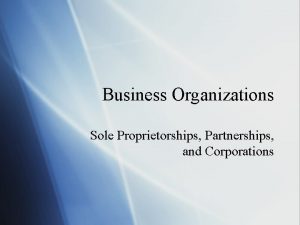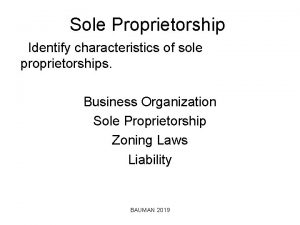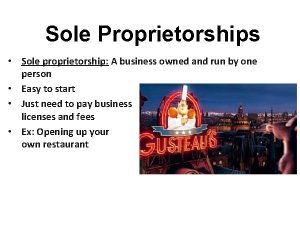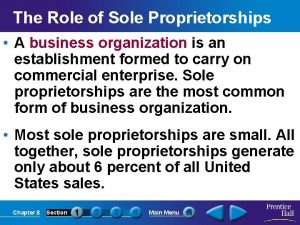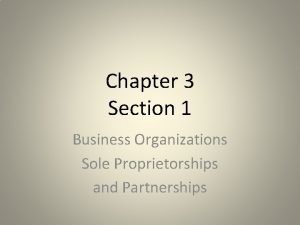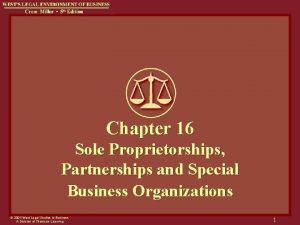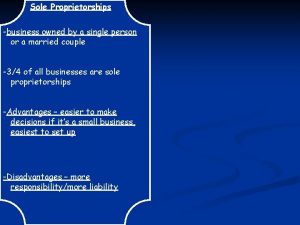Sole Proprietorships What role do sole proprietorships play























- Slides: 23

Sole Proprietorships • What role do sole proprietorships play in our economy? • What are the advantages of a sole proprietorship? • What are the disadvantages of a sole proprietorship? Chapter 8 Section Main Menu

The Role of Sole Proprietorships A sole proprietorship is a business owned and managed by a single individual. Chapter 8 Section Main Menu

Characteristics of Proprietorships • Most sole proprietorships earn modest incomes. • Many proprietors run their businesses part-time. Chapter 8 Section Main Menu

Advantages of Sole Proprietorships Sole proprietorships offer their owners many advantages: Ease of Start-Up Sole Receiver of Profit • • Anyone can start a sole proprietorship. Relatively Few Regulations • Least-regulated form of business organization. Full Control • Section Owners runs businesses as they wish. Easy to Discontinue • Chapter 8 Owner keeps all the profits. No legal obligations need to be met to stop doing business. Main Menu

Disadvantages of Sole Proprietorships • Limited access to resources. • Sole proprietorships also lack permanence. The biggest disadvantage of sole proprietorships is unlimited personal liability. Liability is the legally bound obligation to pay debts. If you default on a business debt, your lenders can come after your personal assets. Chapter 8 Section Main Menu

Partnerships • What types of partnerships exist? • What are the advantages of partnerships? • What are the disadvantages of partnerships? Chapter 8 Section Main Menu

Types of Partnerships If two or more individuals, or companies, have decided to go into business together, they form a partnership. Partnerships fall into three categories: • General Partnership – Partners share equally in both responsibility and liability. • Limited Partnership – Only one partner is required to be a general partner, or to have unlimited personal liability for the firm. • Limited Liability Partnership – In this form, all partners are limited partners. Chapter 8 Section Main Menu

Advantages of Partnerships • Partnerships offer entrepreneurs many benefits. 1. Ease of Start-Up Partnerships are easy to establish. No required partnership agreement, but it is recommended that partners develop articles of partnership. 2. Shared Decision Making and Specialization Each partner brings different strengths and skills to the business. 3. Larger Pool of Capital Each partner's assets, or money and other valuables, improve the firm's ability to borrow funds for operations or expansion. 4. Taxation Individual partners are subject to taxes, but the business itself does not have to pay taxes. Chapter 8 Section Main Menu

Disadvantages of Partnerships • Unless the partnership is a limited liability partnership, at least one partner has unlimited liability. • General partners are bound by each other’s actions. • Partnerships also have the potential for conflict. Chapter 8 Section Main Menu

Corporations, Mergers, and Multinationals • What types of corporations exist? • What are the advantages of incorporation? • What are the disadvantages of incorporation? • How can corporations combine? • What role do multinational corporations play? Chapter 8 Section Main Menu

Types of Corporations • A corporation is a legal entity, or being, owned by individual stockholders. • Stocks, or shares, represent a stockholder’s portion of ownership of a corporation. • A corporation which issues stock to a limited a number of people is known as a closely held corporation. • A publicly held corporation, buys and sells its stock on the open market. Chapter 8 Section Main Menu

Advantages of Incorporation Advantages for the Stockholders Advantages for the Corporation • Individual investors do not carry responsibility. • Potential for more growth than other business forms. • Stock is transferable. • Can borrow money by selling bonds. • Can hire the best available labor to create and market the best services or goods possible. • Have long lives. Chapter 8 Section Main Menu

Disadvantages of Incorporation Difficulty and Expense of Start-Up Charters can be expensive and time consuming to establish. A state license, known as a certificate of incorporation, must be obtained. Double Taxation Corporations pay taxes on their income. Owners also pay taxes on dividends, or the portion of the corporate profits paid to them. Loss of Control Managers and boards of directors, not owners, manage corporations. More Regulation Face more regulations than other kinds of business organizations. Chapter 8 Section Main Menu

Corporate Combinations • Horizontal mergers combine two or more firms competing in the same market with the same good or service. Ex. AOL/Time Warner, T Mobile/AT&T • Vertical mergers combine two or more firms involved in different stages of producing the same good or service. Ex. Time Warner (cable)/Turner Broadcasting (programming) • A conglomerate is a business combination merging more than three businesses that make unrelated products. Ex. Johnson & Johnson Chapter 8 Section Main Menu

Multinationals Multinational corporations (MNCs) are large corporations headquartered in one country that have subsidiaries throughout the world. Examples: American Express, IBM, Dunkin Donuts Chapter 8 Section Main Menu

Other Organizations • How do business franchises work? • What are three types of cooperative organizations? • What are nonprofit organizations? Chapter 8 Section Main Menu

Business Franchises • Franchisers develop products and business systems, then local franchise owners help to produce and sell those products. • Franchises allow owners a degree of control, as well as support from the parent company. A business franchise is a semi-independent business that pays fees to a parent company in return for the exclusive right to sell a certain product or service in a given area. Chapter 8 Section Main Menu

Top 10 Franchises of 2011 1. Hampton Hotels 2. AM PM 3. Mc. Donald’s 4. 7 -Eleven Inc. 5. Supercuts 6. Days Inn 7. Vanguard Cleaning Systems 8. Servpro 9. Subway 10. Denny’s Chapter 8 Section Main Menu

Advantages and Disadvantages of Business Franchises Advantages of Business Franchises Disadvantages of Business Franchises • Management training and support • High franchising fees and royalties • Standardized quality • Strict operating standards • National advertising programs • Purchasing restrictions • Financial assistance • Limited product line • Centralized buying power Chapter 8 Section Main Menu

Nonprofit Organizations Professional organizations work to improve the image, working conditions, and skill levels of people in particular occupations. Trade Associations Nonprofit organizations that promote the interests of particular industries are called trade associations. Business Associations Business associations promote the business interests of a city, state, or other geographical area, or of a group of similar businesses. Labor Unions A labor union is an organized group of workers whose aim is to improve working conditions, hours, wages, and fringe benefits. Institutions that function like business organizations, but do not operate for profits are nonprofit organizations. Nonprofit organizations are exempt from federal income taxes. Chapter 8 Section Main Menu

Student Question • If you were to start a company what would it be? • Sole Proprietorship • What type of company would you want to start? Why? • Corporation Chapter 8 Section • Partnership • Non Profit Main Menu

Section 4 Assessment 1. A business franchise (a) attempts to improve the image and working conditions of people in a particular occupation. (b) operates without the aim of profit. (c) is a semi-independent business tied to a parent company. (d) is not required to pay income taxes. 2. Consumer cooperatives (a) are owned and operated by consumers. (b) provide a service, rather than a good. (c) help members sell their agricultural products. (d) pay no income tax. Want to connect to the PHSchool. com link for this section? Click Here! Chapter 8 Section Main Menu

Section 4 Assessment 1. A business franchise (a) attempts to improve the image and working conditions of people in a particular occupation. (b) operates without the aim of profit. (c) is a semi-independent business tied to a parent company. (d) is not required to pay income taxes. 2. Consumer cooperatives (a) are owned and operated by consumers. (b) provide a service, rather than a good. (c) help members sell their agricultural products. (d) pay no income tax. Want to connect to the PHSchool. com link for this section? Click Here! Chapter 8 Section Main Menu
 Chapter 8 section 1 sole proprietorships
Chapter 8 section 1 sole proprietorships Play by play
Play by play Hamlet kim
Hamlet kim I've got a friend we like to play we play together
I've got a friend we like to play we play together Louise made the chocolate cake active or passive
Louise made the chocolate cake active or passive Shopping role play
Shopping role play Role play on healthy food and junk food
Role play on healthy food and junk food Constitutional convention role play
Constitutional convention role play What role do anthropologists play in solving crimes
What role do anthropologists play in solving crimes Feedback role play
Feedback role play Fungus plural form
Fungus plural form Mitosis
Mitosis Deca role play tips
Deca role play tips What role should consumerism play in our economy
What role should consumerism play in our economy Refusal skills definition
Refusal skills definition Tour guide role play script
Tour guide role play script Mmi role play examples
Mmi role play examples Forecasts play an important role in
Forecasts play an important role in Role play rubrics example
Role play rubrics example Of junk food
Of junk food How did montresor know that the house would be empty?
How did montresor know that the house would be empty? Difficult conversations role play scenarios
Difficult conversations role play scenarios What role does the ribosome play in assembling proteins?
What role does the ribosome play in assembling proteins? John has hinted that he doesn't wish to remain in the group
John has hinted that he doesn't wish to remain in the group
